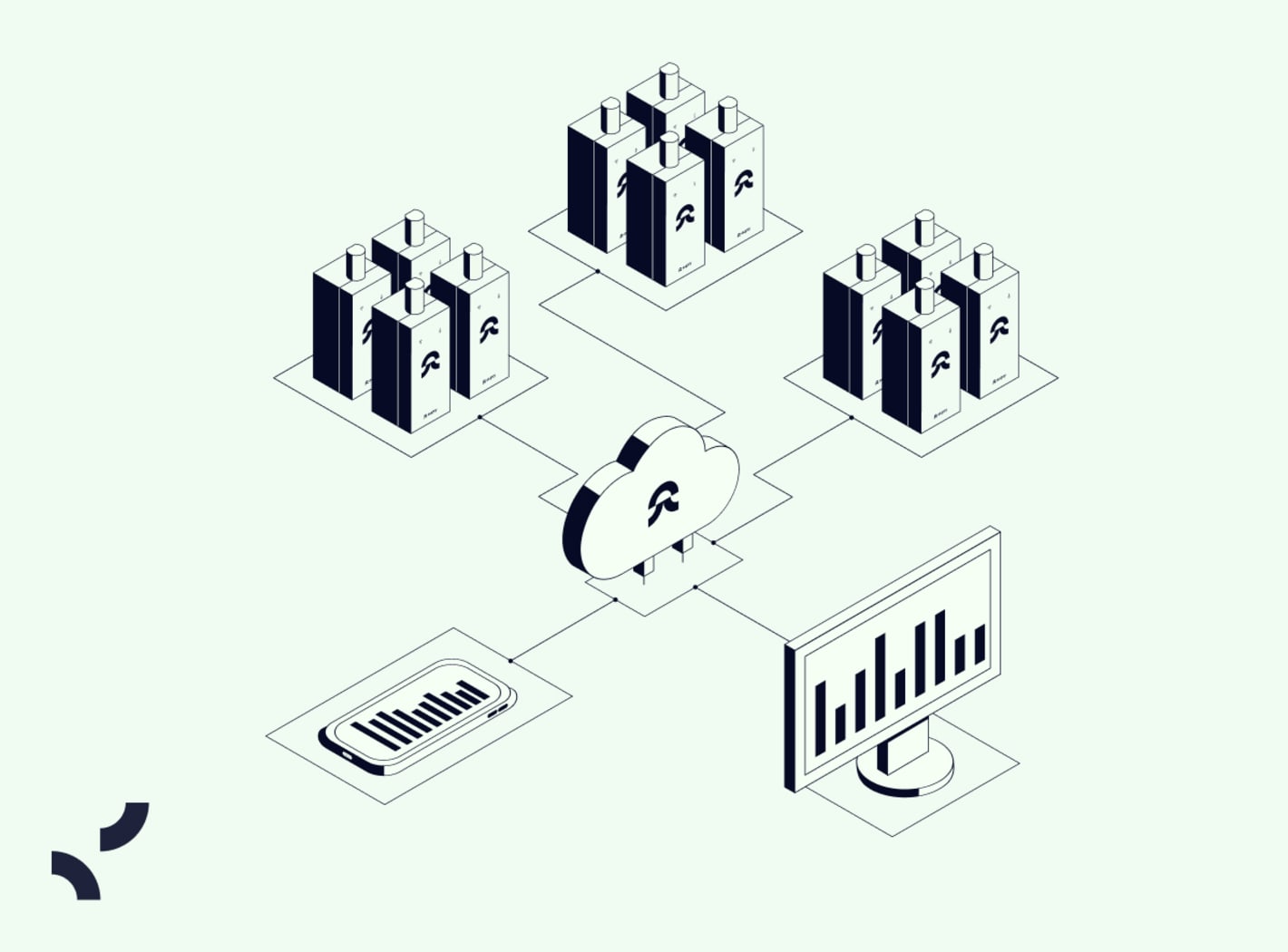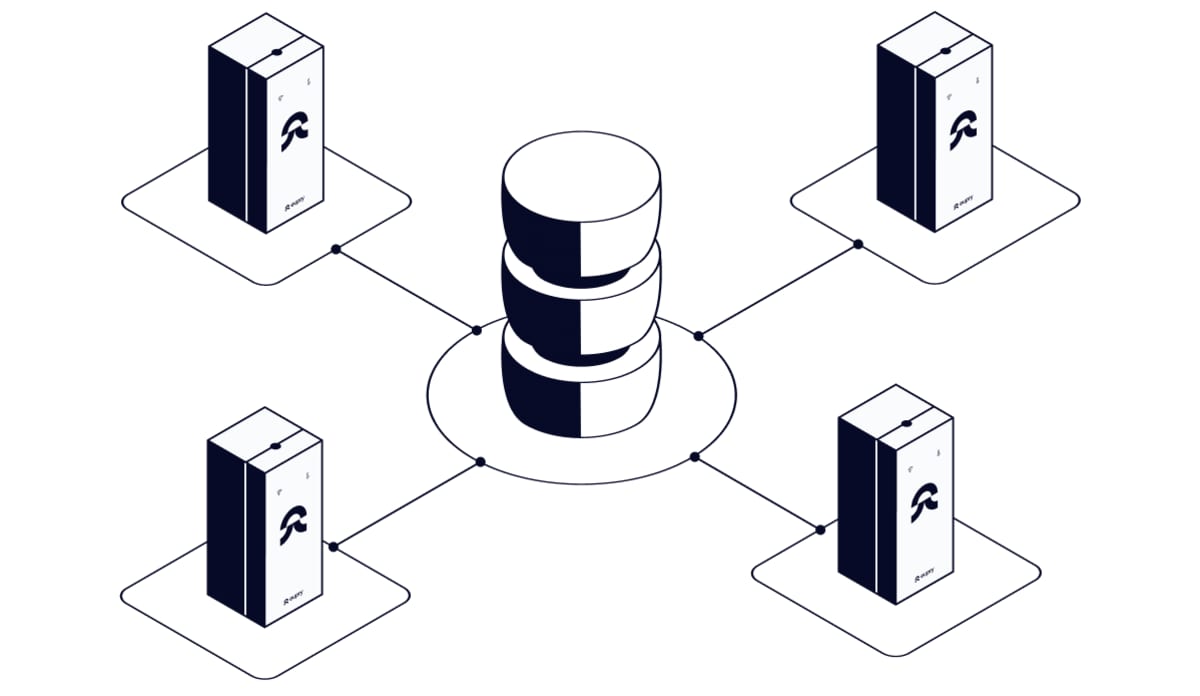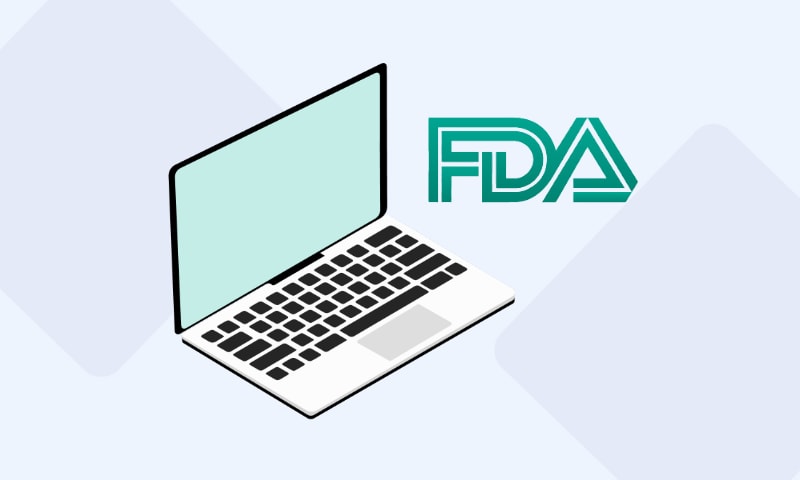A step-by-step guide to choosing the right temperature monitoring system
Temperature monitoring is a vital part of securing product safety and regulatory compliance for many industries – and at the heart of this task lies an effective temperature monitoring system.
Explore the world of thermal monitoring systems, how they work, and how to spot the right fit for your company.

On this page, you can learn about:
- What a temperature monitoring system is and how they work
- The key elements of a temperature monitoring system
- 3 types of temperature monitoring systems (and when to use them)
- 13 features that distinguish top-tier temperature monitoring systems
- Choosing the right monitoring system for your equipment
- Choosing the right temperature monitoring system for your industry
- 10 shortcomings to look out for when choosing a monitoring system


What is a temperature monitoring system?
A wide array of products in industries like pharma, biotech, and logistics are sensitive to temperature fluctuations, and maintaining suitable conditions is vital to prevent spoilage, degradation, and loss of efficacy, vital for consumer safety and the integrity of critical research.
As a result, monitoring temperatures (and often also humidity levels) is necessary to conclude whether conditions are within acceptable ranges. Temperature monitoring systems are the tools that provide this insight.
You can read more about temperature monitoring and why it is important below.

How do temperature monitoring systems work?
Temperature monitoring systems operate on a straightforward yet sophisticated principle: They continuously surveil temperature to make sure the content of a specific environment is stored safely. These environments can be anything from fridges or ULT freezers to large-scale warehouses.
Fundamentally, temperature monitoring systems:
- Record: At the core of the system are temperature monitoring devices, typically data loggers equipped with precise sensors, that record and log temperature readings (in some cases, humidity levels too).
- Transfer: These readings are then transmitted, either automatically or through manual USB exports, to a centralized monitoring platform.
- Analyze: The platform serves as the operational hub, where users can keep an eye on environmental conditions and be alerted to deviations. Depending on sophistication, monitoring will take place either in real-time or staggered, and the platform includes different features designed to ease temperature compliance efforts. Dive into the potential features in the next section.
The key elements of a temperature monitoring system
A system monitoring temperature or humidity will typically consist of three key temperature monitoring devices: temperature sensors, data loggers, and monitoring software.
- Temperature sensors: Sensors measure the temperature conditions. They are designed to operate in various conditions, from extreme cold to high heat, and, when applicable, humidity sensors can also be utilized to monitor relative humidity levels.
- Temperature data loggers: Data loggers record and store the data measured by the sensors. They receive a signal from the sensors and are equipped with internal memory and processors to record, store, and sometimes even analyze the temperature data. Some loggers can store vast amounts of data over extended periods, and they can be wired or wireless, depending on the system's design.
- Monitoring platform: Software that works as the system's interface. Here the data collected by the loggers is analyzed and displayed and depending on the system, alerts or notifications can be triggered in case of deviations.
Cloud-based monitoring platforms
The latest in temperature monitoring technology is cloud-based platforms that integrate with various sensors. These platforms collect and analyze data, offering advanced analytics, trend forecasting, and even predictive maintenance prompts. The cloud's scalability and accessibility make it an excellent option for companies managing multiple locations.
Eupry does all of this and more.

3 different types of temperature monitoring systems – and when to use them
From wired, manual, and USB-driven systems to fully automated temperature monitoring solutions – here are the high-level system types and use cases.
Based on the way data is collected, stored, and analyzed, temperature monitoring systems can be grouped into the following categories:
1. The wired temperature monitoring systems
In a wired system, data from sensors is transmitted to a central monitoring hub through physical cables.
This setup can lead to many potential headaches. Wired installation is complex and less flexible compared to wireless alternatives, and gathering data involves multiple departments, adding to the complexity. Last but not least, the costs for such solutions can be extensive and often add up to expenses more than 10 times higher than a wireless solution. Just running the cable to the storage unit will often require several thousand dollars in costs, and then sensors, software, and salaries are added. Calibration technicians have to go on-site to calibrate making the cost of this equally inproportional.
Historically, this approach was needed to maintain consistent data transmission, especially in areas where wireless connections were unstable or prone to interference. Modern advancements in wireless temperature monitoring technology, however, have increasingly addressed these connectivity issues, making wireless systems more reliable even in environments that previously posed significant challenges for wireless signals – in other words, the time of wired temperature monitoring systems is quickly coming to an end.
- Advantages: The system provides stable data transmission that ensures reliable monitoring, especially in environments with potential wireless interference.
- Limitations: Installation is complex and inflexible due to the need for running physical cables, posing challenges in dynamic or spatially constrained settings, data is tricky and time-consuming to retrieve, and costs are often extremely high.

2. The USB-enabled wireless temperature monitoring systems
This type of system employs wireless data loggers. The collected data is subsequently transferred to a computer or network through manual USB transfers.
Such systems are advantageous for their enhanced flexibility in positioning sensors, unlike their wired counterparts. They are particularly beneficial in scenarios where immediate, real-time monitoring is not a critical requirement. However, a notable drawback is the considerable workload connected to retrieving and sifting through data.
- Advantages: The system offers enhanced flexibility in sensor placement compared to wired solutions.
- Limitations: Staggered monitoring means that deviations cannot be acted upon immediately, and the setup requires significant manual effort for data extraction and analysis, particularly during audits or when specific information is needed.


The free compliance guide:
6 strategies to spend (way) less time on manual temperature compliance
3. The Wi-Fi-based wireless temperature monitoring systems
In the realm of thermal monitoring, the latest advancements have brought us wireless Wi-Fi-based monitoring systems.
Wi-Fi-based systems use wireless sensors to measure data and transmit the data over a Wi-Fi network to a central system. This setup allows real-time data tracking and analysis, accessible from any location with internet access. Immediate alerts and updates can be sent directly to smartphones or computers, enabling prompt response to any temperature changes to mitigate risks.
- Advantages: The system provides automatic data transfer (no need for manual data transfers), live access from any location, instant alerts, and often digital audit reporting.
- Limitations: They depend on stable connections, which might be problematic in areas with weak network signals, but more sophisticated systems address this by using alternatives like mobile networks or continuous data storage.
This system offers maximum convenience and compliance and is ideal for environments where immediate response to temperature fluctuations is essential – for instance, pharmaceutical production or biotech research settings.
Other types of thermal monitoring systems
Other variations of temperature monitoring systems include Bluetooth-enabled devices that pair with local receivers or smartphone apps for data collection within a short range, ZigBee/Z-Wave mesh networks that enhance connectivity through devices acting as signal repeaters, and cellular-based sensors that transmit data via mobile networks, ideal for remote or in-transit conditions without Wi-Fi or wired infrastructure.
Each type of system has its benefits and is suited to different operational needs. Wired systems are reliable but fixed and costly, USB-based systems are flexible but require manual work, and Wi-Fi-based systems offer the greatest convenience and immediacy for data access and analysis.

Mess-free temperature monitoring with Eupry
Eupry’s temperature compliance solution is designed to be customized to the differing requirements of different industries, equipment types, and regulatory needs.

Monitor in real-time on any screen
Audit reporting in 3 clicks
Calibrate without swapping devices
One digital source of truth for all data
Automated and always-on data transfer
How to choose a temperature monitoring system?
What features separate an okay temperature monitoring system from a great one? When dealing with various equipment, what factors should you consider? In industries like pharma, logistics, and biotech, what key aspects should you focus on? And what are the weaknesses to look out for?
There is a temperature monitoring solution for any use – and there are several considerations to make when choosing the right fit for you.
Let us go through the most important ones.
13 features that distinguish top-tier temperature monitoring systems
Although temperature monitoring systems work in similar ways, there is a world of difference in both features, the required (manual) effort, and compliance levels.
The key functions setting apart sophisticated temperature monitoring systems:
How to choose the right temperature monitoring system for your equipment
Apart from their data collection methods, temperature monitoring systems and devices vary based on the specific environment or equipment they are designed for.
Freezer and fridge temperature monitoring system
Whether wired or wireless, temperature monitoring setups for freezers will include features specially designed for low temperatures such as alarms for out-of-range temperatures. The connected data loggers will include thermal sensors sustainable at low temperatures.
For ULT freezers, this requires external sensors as the technology in the actual logger will most often not be able to sustain the extremely low temperatures of this equipment.

Laboratory temperature monitoring system
Precision is paramount in a pharma or biotech lab setting, and laboratory temperature monitoring systems are engineered to ensure adherence to the stringent regulatory standards governing these environments, ensuring that experiments and processes are performed within thermal parameters.
To support compliance demands, these solutions typically feature data loggers with high-accuracy sensors and come with calibration options that are either traceable or fully accredited. Additionally, some will include features for audit efficiency, providing straightforward access to calibration certificates and facilitating their integration into audit-ready reports.

Walk-in cooler temperature monitoring system
Designed for large-scale refrigeration, a temperature monitoring system for walk-in coolers monitors the internal conditions. Features typically include door sensors to track access, energy usage monitoring to optimize operations, and automated reports to aid in compliance.
Typically a walk-in cooler needs several monitoring sensoring points to make sure temperature deviations within are not exceeding limits. To determine sensor location a temperature mapping exercise can be performed. Often, it is also wanted to monitor the performance of the cooling unit which among other ways can be done by measuring if the cooling unit is powered.

Warehouse temperature monitoring system
A warehouse temperature monitoring system is integral to maintaining the right conditions in vast spaces where temperature gradients can occur.
These systems will offer remote monitoring and comprehensive coverage that often requires a network of sensors to provide spatial temperature data and ensure uniformity across different zones. Advanced systems can include integration with HVAC systems for automated climate control.

Storage container temperature monitoring system
Ensuring stable temperatures in storage containers requires a system that can adapt to varying external conditions and connection challenges. These setups will typically include strategically placed sensors to account for the changing outdoor environment, wireless connectivity to make data retrieval without needing physical access possible, and battery-powered routers that can circumvent potential issues with connectivity.
These features are indispensable for the requirements of the logistics sector.

How to choose the right temperature monitoring system for your industry
Depending on the components, sophisticated temperature monitoring systems can be tailored to suit the environment they serve – from simple, robust monitoring to complex, high-precision systems. Hence, your perfect program fit depends on the space you operate in.
Whether it is logistics, pharmaceuticals, biotechnology, or other regulated industries – here are a few things to look for when choosing a temperature monitoring system for your industry.

Temperature monitoring systems for logistics
Look for reliable temperature monitoring solutions that can handle the challenges of securing data integrity during both transport and storage.
Also, consider the capability to adapt to the distribution of highly sensitive products, such as pharmaceuticals. Even if your company doesn't currently work in this area, having systems that meet the demands of these types of products can simplify future expansion.
Flexibility in calibration options can be a cost-saving advantage, allowing you to switch between accredited and traceable calibration, without compromising GDP compliance following the requirements of the FDA and other regulatory authorities.
For instance, look for:
- reliable wireless connectivity and mobile network support.
- adherence to Good Distribution Practices (GDP) and FDA considerations.
- data loggers that offer durability and offsite, Wi-Fi-based monitoring.
- scalability to large-scale facilities like warehouses and distribution centers.
- flexibility in compliance levels – for instance in accredited vs. traceable calibration – to adapt to various types of goods and reduce costs when possible.
Temperature monitoring systems for biotech
Go for flexible and customizable solutions to support varied research and development environments – with capabilities for rapid changes.
For biotech, choosing a temperature monitoring system that features automated data recording, real-time monitoring with instant alerts, and reliable deviation management can support data integrity and quality control, ensuring the balance required for sensitive samples, living cell cultures, biological reagents, and other high-value material is maintained.
As with pharma, compliance requirements are high, and similar features should be considered: FDA 21 CFR Part 11 compliance, data security, audit-easing tools, and R&D to GDP compliance.
For instance, look for:
- high-precision sensors and accredited calibration that supports Good Laboratory Practice (GLP).
- robust deviation management, digital reporting tools, and other features that will make your auditing process easier.
- scalability, easy onboarding, and user-friendliness to support the growth of your operation.
- automated, live data recording, real-time alerts, and reliable backups to support data integrity.
- compliance features based on your specific regulatory needs.
- a financial model that supports and adapts to your budget.

Temperature monitoring systems for pharma
Look for a robust monitoring system with an emphasis on regulatory compliance – that evolves with them. Ideal solutions should offer accredited calibrations, secure data protection, and features that comply with requirements. Additionally, auditing is a necessary, often time-consuming, evil for many pharmaceutical companies; look for solutions that will make this process less straining.
Temperature monitoring systems for pharma should cater to the entire pharma lifecycle from R&D to drug distribution and logistics, ensuring GMP and GDP compliance.
For instance, look for:
- features that will make your audit processes simpler – such as digital reporting tools.
- ISO 17025 accredited calibration included, secure data handling, and features supporting regulations like FDA 21 CFR Part 11.
- processes designed to adapt to the evolving regulation landscape.
- dependable backup systems, automated data capture, live monitoring, and instant alerts to maintain data integrity.
- a system that scales to mass production and can easily adapt to all stages of the pharmaceutical value chain from development and manufacturing to distribution.

Temperature monitoring systems for cosmetics
Choose a system that offers flexibility to handle fast product turnover as well as broad regulatory compliance.
For instance, look for:
- a system that supports the fast product turnover of the cosmetics industry by providing easy installation, scalability, and data access.
- compliance with Good Manufacturing Practices (GMP) and adherence to specific national and international standards (like ISO and FDA guidelines).
- a versatile system supporting both routine and complex monitoring needs.

Temperature monitoring systems for other industries
Many monitoring solutions are also applicable to other industries with temperature-sensitive products, such as biopharma, cell and gene (part of biotech), medical cannabis, cosmetics, and healthcare. In every case, the system should offer full control over the process and easy access to the data you need.
Tip! Some systems will be designed for one specific purpose and others tailored to fit more requirements. As a rule of thumb, if a solution lives up to the needs of the pharmaceutical industry, most other sectors will also be covered.

How Eupry’s wireless temperature monitoring solution works (also in your industry)
Eupry’s temperature monitoring and compliance solution is flexible and can be customized to live up to the strict regulatory requirements of the pharma industry, the fast pace of biotech, and the combined needs of distribution.
Tip!
If you plan on expanding or in other ways changing your operations, choose a temperature monitoring system that grows with your company.
Scalability is a key factor. As your operations change, so should your monitoring system – both in size and capabilities. Choose a system that adapts to increased demands, changing environments, and evolving industry regulations. The ability to scale ensures that your investment remains relevant and saves you from the hassle of constant system upgrades or replacements.
So, which type of system adapts easily?
Wi-Fi-based wireless systems shine in scalability. With the ability to add more sensors and expand coverage across multiple locations easily, remote monitoring capabilities, and cloud-based data storage offer, they are ideal for growth. As your operation changes, these systems can change with you, maintaining consistent, reliable monitoring without a proportional increase in complexity or cost.
Need a system that grows with you? Learn more about the flexibility of our wireless system and subscription-based model.
10 shortcomings to look out for when choosing a temperature monitoring system
Navigating the landscape of temperature monitoring systems also means spotting the potential issues – each of which can cost you both process effectiveness and compliance levels.
Being able to detect these shortcomings will ease the process of choosing the right monitoring system for you.
10 weaknesses to watch for in temperature monitoring systems:

Make temperature compliance a non-issue
Eupry is monitoring, mapping, and calibration done smarter.
It is one source of all data, a real-time overview, reporting in 3 clicks, and calibration included.
So that you can trust your compliance without having to do the work.
Sounds too good to be true?
We get that. So let us explain how it works.
Let's talk for 15 minutes
What we have learned
You have explored the comprehensive world of temperature monitoring systems – from understanding their fundamental role in ensuring product safety and compliance to delving into the types and functionalities tailored to different needs.
Let us sum up:
- Different types of systems – wired, USB-enabled wireless, or Wi-Fi-based – come with different advantages and limitations.
- The specific requirements of your industry – be it logistics, biotech, pharma, or others – need to be embodied in the right temperature monitoring system for you.
- Understanding the potential shortcomings of these systems is just as crucial as recognizing their strengths.
- The right temperature monitoring solution not only aligns with your current needs but also adapts to future challenges and growth.
With this guide, you're now equipped with the knowledge to navigate the landscape of temperature monitoring systems, ensuring you make a choice that adds value, ensures compliance, and protects the integrity of your products.
By considering the unique advantages of each system, you can select a temperature monitoring solution that aligns with your operational requirements, ensuring product integrity, regulatory compliance, and optimal performance.

3 ways to dive deeper
Ready to dive deeper or need specific advice for your situation? Explore further and find the perfect fit for your business needs.

How to master temperature monitoring in critical environments

21 CFR Part 11 compliant monitoring systems: What to look for?

How to unify temperature compliance to minimize manual work

The free compliance guide
6 methods to spend (way) less time on manual temperature compliance
Learning videos
Check out our on-demand webinar about everything from understanding 21 CFR Par 11 for temperature monitoring to strategic advice for automating your entire temperature compliance.